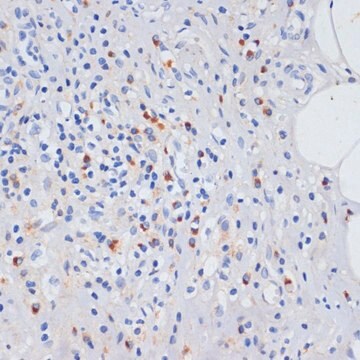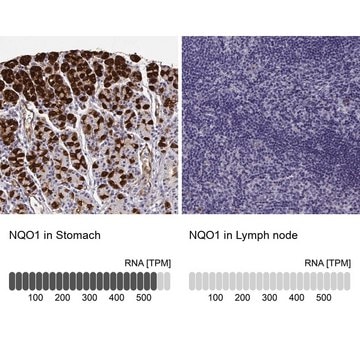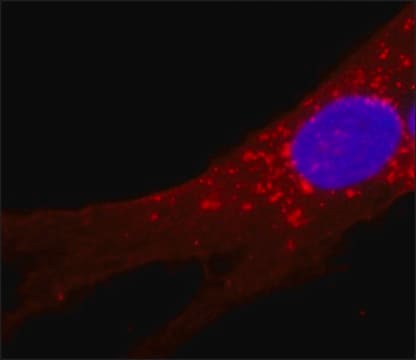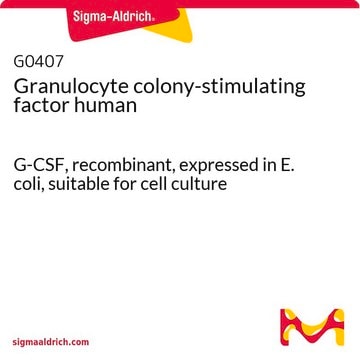一般說明
We are committed to bringing you greener alternative products, which adhere to one or more of The 12 Principles of Green Chemistry.This antibody is Preservative-free, produced without the harm or sacrifice of animals and exceptionally stable to allow for ambient shipping and storage if needed and thus aligns with "Waste Prevention", "Designing Safer Chemicals" and "Design for Energy Efficiency".
Click here for more information.
ZooMAb® antibodies represent an entirely new generation of recombinant monoclonal antibodies.
Each ZooMAb® antibody is manufactured using our proprietary recombinant expression system, purified to homogeneity, and precisely dispensed to produce robust and highly reproducible lot-to-lot consistency. Only top-performing clones are released for use by researchers. Each antibody is validated for high specificity and affinity across multiple applications, including its most commonly used application. ZooMAb® antibodies are reliably available and ready to ship when you need them.
特異性
Clone 2N20 is a ZooMAb® Rabbit recombinant monoclonal antibody that detects Toll-like receptor 4 (TLR4). It targets an epitope within 16 amino acids from the extracellular domain.
免疫原
KLH-conjugated linear peptide corresponding to 16 amino acids from the extracellular domain within the N-terminal half of Toll-like receptor 4 (TLR4).
應用
Quality Control Testing
Evaluated by Immunohistochemistry (Paraffin) in human bone marrow tissue sections.
Immunohistochemistry (Paraffin) Analysis: A 1:1,000 dilution of this antibody detected TLR4 in human bone marrow tissue sections.
Tested applications
Immunohistochemistry (Paraffin) Analysis: A 1:1,000 dilution from a representative lot detected TLR4 in human skin tissue sections.
Affinity Binding Assay: A representative lot of this antibody bound TLR4 with a KD of 1.4 x 10-7 in an affinity binding assay.
Flow Cytometry Analysis: 1 μg from a representative lot detected TLR4 in one million U2OS cells.
Immunocytochemistry Analysis: A 1:100 dilution from a representative lot detected TLR4 in U2OS cells.
Note: Actual optimal working dilutions must be determined by end user as specimens, and experimental conditions may vary with the end user
標靶描述
Toll-like receptor 4 (UniProt: O00206; also known as EC:3.2.2.6, hToll, CD284, TLR4) is encoded by the TLR4 gene (Gene ID: 7099) in human. Toll-like Receptors (TLRs) are transmembrane proteins that are expressed on various immune cells. They recognize specific molecular patterns associated with pathogenic species and provide an early defense mechanism against foreign organisms. They contain an N-terminal extracellular and a C-terminal cytoplasmic domain. The N-terminal region contains leucine-rich repeats (LRR) that recognize specific pathogen components. Although the ligand recognition mechanisms of the TLRs vary significantly, all TLR dimers exhibit similar overall arrangement. At least 13 different members of TLR family have been identified that detect different pathogen associated molecular patterns (PAMPs). TLR4 is a single-pass type I membrane glycoprotein that is highly expressed in heart, spleen, lung, muscle, and macrophages. It is synthesized with a signal peptide (aa 1-23), which is subsequently cleaved off to produce the mature form that contains an extracellular domain (aa 24-631), a transmembrane domain (aa 632-652), and a cytoplasmic domain (aa 653-89). TLR4 cooperates with LY96 and CD14 to mediate the innate immune response to bacterial lipopolysaccharide. It acts via MYD88, TIRAP and TRAF6, leading to NF-kB activation, cytokine secretion and the inflammatory response. In complex with TLR6, it also promotes sterile inflammation in monocytes/macrophages in response to oxidized low-density lipoprotein. It is also shown to be a crucial mediator in oxLDL-induced inflammatory cytokine expression and secretion in smooth muscle cells. TLR4 contains 18 LRR repeats and one TIR domain (aa 672-815) that mediates NAD+ hydrolase activity. D17 (Ref.: Yang, K., et al. (2014). PLoS ONE 9(4); e95935; Akashi, S., et al. (2000). J. Immunol. 164; :3471-3475).
外觀
Purified recombinant rabbit monoclonal antibody IgG, lyophilized in PBS, 5% Trehalose, normal appearance a coarse or translucent resin. The PBS/trehalose components in the ZooMAb formulation can have the appearance of a semi-solid (bead like gel) after lyophilization. This is a normal phenomenon. Please follow the recommended reconstitution procedure in the data sheet to dissolve the semi-solid, bead-like, gel-appearing material. The resulting antibody solution is completely stable and functional as proven by full functional testing. Contains no biocide or preservatives, such as azide, or any animal by-products. Larger pack sizes provided as multiples of 25 μL.
重構
300 μg/mL after reconstitution at 25 μL per vial. Please refer to guidance on suggested starting dilutions and/or titers per application and sample type.
儲存和穩定性
Recommend storage of lyophilized product at 2-8°C; Before reconstitution, micro-centrifuge vials briefly to spin down material to bottom of the vial; Reconstitute each vial by adding 25 μL of filtered lab grade water or PBS; Reconstituted antibodies can be stored at 2-8°C, or -20°C for long term storage. Avoid repeated freeze-thaws.
法律資訊
ZooMAb is a registered trademark of Merck KGaA, Darmstadt, Germany
免責聲明
Unless otherwise stated in our catalog or other company documentation accompanying the product(s), our products are intended for research use only and are not to be used for any other purpose, which includes but is not limited to, unauthorized commercial uses, in vitro diagnostic uses, ex vivo or in vivo therapeutic uses or any type of consumption or application to humans or animals.










